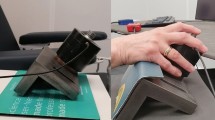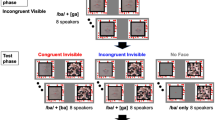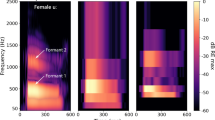Abstract
Visual information from a speaker’s face can enhance1 or interfere with2 accurate auditory perception. This integration of information across auditory and visual streams has been observed in functional imaging studies3,4, and has typically been attributed to the frequency and robustness with which perceivers jointly encounter event-specific information from these two modalities5. Adding the tactile modality has long been considered a crucial next step in understanding multisensory integration. However, previous studies have found an influence of tactile input on speech perception only under limited circumstances, either where perceivers were aware of the task6,7 or where they had received training to establish a cross-modal mapping8,9,10. Here we show that perceivers integrate naturalistic tactile information during auditory speech perception without previous training. Drawing on the observation that some speech sounds produce tiny bursts of aspiration (such as English ‘p’)11, we applied slight, inaudible air puffs on participants’ skin at one of two locations: the right hand or the neck. Syllables heard simultaneously with cutaneous air puffs were more likely to be heard as aspirated (for example, causing participants to mishear ‘b’ as ‘p’). These results demonstrate that perceivers integrate event-relevant tactile information in auditory perception in much the same way as they do visual information.
This is a preview of subscription content, access via your institution
Access options
Subscribe to this journal
Receive 51 print issues and online access
$199.00 per year
only $3.90 per issue
Buy this article
- Purchase on Springer Link
- Instant access to full article PDF
Prices may be subject to local taxes which are calculated during checkout



Similar content being viewed by others
References
Sumby, W. H. & Pollack, I. Visual contribution to speech intelligibility in noise. J. Acoust. Soc. Am. 26, 212–215 (1954)
McGurk, H. & MacDonald, J. W. Hearing lips and seeing voices. Nature 264, 746–748 (1976)
Calvert, G. A. et al. Activation of auditory cortex during silent lipreading. Science 276, 593–596 (1997)
Calvert, G. A. & Campbell, R. Reading speech from still and moving faces: the neural substrates of visible speech. J. Cogn. Neurosci. 15, 57–70 (2003)
Diehl, R. L. & Kluender, K. R. On the objects of speech perception. Ecol. Psychol. 1, 121–144 (1989)
Fowler, C. & Dekle, D. Listening with eye and hand: crossmodal contributions to speech perception. J. Exp. Psychol. Hum. Percept. Perform. 17, 816–828 (1991)
Gick, B., Jóhannsdóttir, K. M., Gibraiel, D. & Mühlbauer, J. Tactile enhancement of auditory and visual speech perception in untrained perceivers. J. Acoust. Soc. Am. 123, EL72–EL76 (2008)
Sparks, D. W., Kuhl, P. K., Edmonds, A. E. & Gray, G. P. Investigating the MESA (multipoint electrotactile speech aid): the transmission of segmental features of speech. J. Acoust. Soc. Am. 63, 246–257 (1978)
Reed, C. M., Durlach, N. I., Braida, L. D. & Schultz, M. C. Analytic study of the Tadoma method: effects of hand position on segmental speech perception. J. Speech Hear. Res. 32, 921–929 (1989)
Bernstein, L. E., Demorest, M. E., Coulter, D. C. & O’ Connell, M. P. Lipreading sentences with vibrotactile vocoders: performance of normal-hearing and hearing-impaired subjects. J. Acoust. Soc. Am. 90, 2971–2984 (1991)
Derrick, D., Anderson, P., Gick, B. & Green, S. Characteristics of air puffs produced in English ‘pa’: data and simulation. J. Acoust. Soc. Am. 125, 2272–2281 (2009)
Lisker, L. & Abramson, A. S. A cross-language study of voicing in initial stops: acoustical measurements. Word 20, 384–423 (1964)
Mizobuchi, K. et al. Single unit responses of human cutaneous mechanoreceptors to air-puff stimulation. Clin. Neurophysiol. 111, 1577–1581 (2000)
Sabah, N. H. Controlled stimulation for hair follicle receptors. J. Appl. Physiol. 36, 256–257 (1974)
Sangras, R., Kwon, O. C. & Faeth, G. M. Self-preserving properties of unsteady round nonbuoyant turbulent starting jets and puffs in still fluids. J. Heat Transfer 124, 460–469 (2002)
Diez, F. J., Sangras, R., Kwon, O. C. & Faeth, G. M. Erratum: “Self-preserving properties of unsteady round nonbuoyant turbulent starting jets and puffs in still fluids. ASME J. Heat Transfer, 124, 460–469 (2002)”. J. Heat Transfer 125, 204–205 (2003)
Stevens, K. N. Acoustic Phonetics Ch. 7 (MIT Press, 1998)
Weinstein, S. in The Skin Sense (ed. Kenshalo, D. R.) 195–222 (Thomas, 1968)
Fu, K.-M. G. et al. Auditory cortical neurons respond to somatosensory stimulation. J. Neurosci. 23, 7510–7515 (2003)
Ito, T., Tiede, M. & Ostry, D. J. Somatosensory function in speech perception. Proc. Natl Acad. Sci. USA 106, 1245–1248 (2009)
Acknowledgements
This research was funded by a Discovery Grant from the Natural Sciences and Engineering Council of Canada to B.G., and by a National Institutes of Health Grant DC-02717 to Haskins Laboratories. We acknowledge the contributions of Y. Ikegami for initial piloting, R. Lee for piloting tapping protocols, L. McLeod for help setting up the University of British Columbia system, G. Ramsay and J. Wang for building switch mechanisms, S. Renardy for organizing protocols, D. H. Whalen for discussion and students of the University of British Columbia’s Interdisciplinary Speech Research Laboratory for organizing participants and other assistance.
Author Contributions B.G. conceived and designed the experiment; D.D. designed and performed the data analysis.
Author information
Authors and Affiliations
Corresponding author
Supplementary information
Supplementary Information
This file contains Supplementary Methods, Supplementary Figure 1 and Legend and Supplementary Tables 1-3. (PDF 1633 kb)
Rights and permissions
About this article
Cite this article
Gick, B., Derrick, D. Aero-tactile integration in speech perception. Nature 462, 502–504 (2009). https://doi.org/10.1038/nature08572
Received:
Accepted:
Issue Date:
DOI: https://doi.org/10.1038/nature08572
This article is cited by
-
Speech-derived haptic stimulation enhances speech recognition in a multi-talker background
Scientific Reports (2023)
-
Is Phonology Embodied? Evidence from Mechanical Stimulation
Journal of Psycholinguistic Research (2022)
-
Bringing back the voice: on the auditory objects of speech perception
Synthese (2021)
-
Electro-Haptic Enhancement of Spatial Hearing in Cochlear Implant Users
Scientific Reports (2020)
-
Enhanced Pitch Discrimination for Cochlear Implant Users with a New Haptic Neuroprosthetic
Scientific Reports (2020)
Comments
By submitting a comment you agree to abide by our Terms and Community Guidelines. If you find something abusive or that does not comply with our terms or guidelines please flag it as inappropriate.



